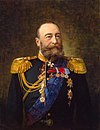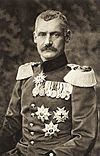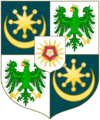Monarchy of Mysia
| King of Mysia | |
|---|---|
 | |
| Incumbent | |
| File:Michael of Mysia.jpg | |
| Michael I since 17 July 2010 | |
| Details | |
| Style | His/Her Apostolic Majesty |
| Heir apparent | Archduke George |
| First monarch | David I |
| Formation | 2 September 1830 |
| Residence | Phaistros (historical) Palataki (modern) |
The Monarch of Mysia, officially the Basileus of Mysia (Perateian: Βασιλεὺς τῆς Ἀρητιάς), is the head of state of the Kingdom of Mysia.
History
The Mysian monarchy traces its claim to the modern Kingdom of Mysia, which ruled over what is the modern Commonwealth of Zalpa in present day Vardana, the islands of Thynia, and coastal Vardana. The Kingdom of Mysia was first ruled by the House of Kamytzes, descending from Perateian emperor Constantine XI Samaras. His son David Kamytzes, held the distinction as Despot of Mysia during latter years of the Perateia-Lihnidos union, and upon its dissolution proclaimed himself Emperor and Autocrat of the Paomanians, and of all the East, Basileus of Mysia, and Emperor of Lihnidos, based on rule in Mysia and descent from Constantine XI Samaras. Mysia would lose its mainland territories to the Hazarasp Kingdom of Vardana in 1901.
At the behest of King George, mainland Mysia again reasserted its independence in 1924, during the Vardanan revolution, which coincided with an invasion of the mainland. However, by 1930 the kingdom had lost its mainland territory and retreated to the islands of Thynia. At George II's death, he was succeeded by his daughter, Irene, and entered a personal union with the Gariman state of Nyrundy. Mysia has been ruled by the House of Nyrundy since 1967 – though Irene's husband John VII, Elector of Nyrundy was Basileus of Mysia by right of his wife from 1933 until his death in 1960. The House of Nyrundy continues to rule Mysia in a personal union with the Gariman Electorate of Nyrundy.
Role
The monarch is the semi-constitutional monarch of Mysia. As head of state, the monarch is the chief executive and chief representative of Mysia abroad. In addition, the monarch wields significant legislative and judicial authority. However, since the 1980s the General Assembly has carried out a growing influence on the legislative process. The monarch carries out executive power through decree or more often the Council of Ministers. Ministers are appointed and removed by the monarch. Historically, the Mysian political system has been derived from legislative action forming out of royal decrees, often In practice, major policy decisions are often derived from the Council of Ministers. From 1945 to 2010, the role of the Grand Logothete saw an expansion of influence due to the physically absent nature of the monarch from Mysia; however, the role was often overshadowed by the Despot (heir apparent) who continues to maintain a major role in government affairs.
While the monarch is the primary judicial authority in Mysia, judicial reforms in the mid-20th century were established to provide Mysia with a modern judiciary that limits the active involvement of the monarch. Typically, the monarch only becomes involved in the late stages of the appellate process and hears a limited number of cases in any given year. This is due to the customary law duty of the monarch to receive and hear petitions from its subjects.
In addition, the monarch is the commander-in-chief of the Mysian Defense Force, as well as the Royal Guard and Civil Guard.
Titles, styles and honors
Mysian royal titles and styles are primarily derived from Perateian emperors. The primary style utilized by the monarch is Majesty ("HM"). Despite currently lacking control of most of Mysia, the monarch continues to claimed the royal titles of Mysia and the Perateian-Lihnidosi personal union. As such many titles utilized by the monarch are simply held in pretense, and remain contested by at least one other claimant or party. Since 1933, the Baselius of Mysia was concurrently the Elector of Nyrundy and Archduke of Nyrundy. Even though Lihnidosi titles such as Emperor of Lihnidos and King of Thasos fell out of active use during the Nyrundy personal union, there has been no explicit renunciation of these claims.
The monarch's current title and style is:
- Basileius, King of Mysia, Elector of Nyrundy, Grand Prince of the East, First Venerable One, Bridger of Seas, Master of the Periclean and the Ozeros, Sovereign Ruler and Lord of the Scipian Provinces and the lands in between, Protector and Defender of the Uniate Faith.
Title of the heir apparent
From 1736 to 1830, the House of Kamytzes held the distinction of Despot of Mysia. Since 1830, this previously non-hereditary administrative title has been granted to the heir apparent or chosen heir of Mysia; however since 1933 has since been changed to Despot of Thynia. The heir is afforded the style of Royal and Apostolic Highness ("HRAH"). The feminine title is Despoina, which differs from that of Despotissa for the wife of the Despot.
Succession
List
| Name | Portrait | Arms | Birth | Marriages | Death | Claim |
|---|---|---|---|---|---|---|
| David I (Δαβιδ Αʹ) 2 September 1830 – 1 June 1861 |

|

|
1 January 1799 Leonopolis Son of David, Despot of Mysia and Anna Levidis |
Maria of Ravenna Hagia Anthemia 9 June 1829 5 children |
1 June 1861 Norashen aged 62 |
Hereditary Despot of Mysia Royal governor of Mysia |
| David II (Δαβιδ Βʹ) 1 June 1861 – 8 March 1864 |

|

|
16 July 1831 Phaistros Son of David I and Maria of Ravenna |
Anastasia Malenia Hagia Anna DATE 2 children |
30 May 1869 Pelias aged 37 |
Eldest son of David I |
| Andreas I (Ανδρεασ Αʹ) 8 March 1864 – 4 June 1881 |

|

|
22 April 1804 Phaistros Son of David, Despot of Mysia and Anna Levidis |
Stephania Byzennina Hagia Anna DATE 8 children |
4 June 1881 Tzantzakon aged 77 |
Uncle of David I |
| George I (Γεώργιος Αʹ) 4 June 1881 – 28 November 1890 |

|

|
9 September 1828 Phaistros Son of Andreas I and Stephania Byzennina |
PLACEHOLDER Hagia Anna DATE 1 child |
28 November 1890 Perivolia aged 62 |
Eldest son of Andreas I |
| George II (Γεώργιος Βʹ) 28 November 1890 – 3 May 1933 |

|

|
26 February 1852 Phaistros Son of George I and PLACEHOLDER |
Agnes of Latium Hagia Anthemia 18 May 1896 8 children |
3 May 1933 Phaistros aged 81 |
Eldest son of George I |
| Irene I (Ειρήνη Αʹ) 3 May 1933 – 4 May 1967 |

|

|
1 July 1895 Phaistros Daughter of George II and Agnes of Latium |
John VII, Elector of Nyrundy Rovan 1914 3 children |
4 May 1967 Rovan aged 70 |
Daughter and eldest surviving child of George II |
| (Jure uxoris) John I (Ιωάννης Αʹ) 3 May 1933 – 8 December 1960 |

|

|
11 January 1890 Rovan Son of Otto X, Elector of Nyrundy and Enora Rouanti |
Irene I of Mysia Rovan 1914 5 children |
8 December 1960 Rovan aged 70 |
Husband of Irene I of Mysia |
| Stephen I (Στέφανος Αʹ) 4 May 1967 – 17 June 1984 |

|
17 May 1915 Rovan Son of Irene I and John VII, Elector of Nyrundy |
Silvia of Ravenna Rovan 4 February 1936 5 children |
17 June 1984 Rovan aged 69 |
Eldest son of Irene I | |
| George III (Γεώργιος Γʹ) 17 June 1984 – 17 July 2010 |

|
30 May 1937 Palataki Son of Stephen I and Silvia of Ravenna |
Anna of Ghant Rovan 17 January 1961 6 children |
17 July 2010 Rovan aged 73 |
Eldest son of Stephen I | |
| Michael I (Μιχαὴλ Αʹ) 17 July 2010 – present |

|
1 January 1962 Rovan Son of George III and Anna of Ghant |
Fausta Tarpeia Rovan 17 January 1961 6 children |
Living age 62 |
Eldest son of George III |